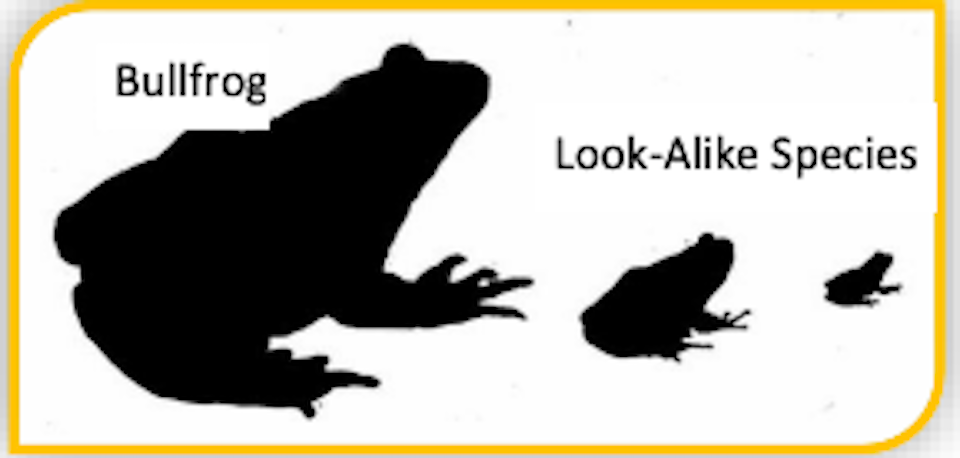Known for their trademark throaty call, bullfrogs make their presence known in the areas they inhabit.
But the large amphibians aren't supposed to live in British Columbia and they are causing serious harm to local ecosystems.
American Bullfrogs aren't your average carnivore. As researcher Leigh Anne Isaac puts it, "They eat everything." And that spells disaster for native species across the Lower Mainland and on 91原创 Island where populations of the foreign amphibian are increasing.
Isaac, who is B.C.'s Small Mammal and Herpetofauna Specialist, told V.I.A. that the bullfrogs were introduced to the province for frog-farming purposes. Almost cartoonishly cute, American bullfrogs have rotund bodies with large, meaty legs that are ideal for "frog leg" markets.
The large animals maintain their stature by constant consumption -- and they are far from particular. Their carnivorous diet consists of everything from mammals and insects to birds and lizards and even other amphibians. It isn't uncommon to , a mouse, or another frog. Provided it can get its mouth around it, it's fair food game.
They are native to eastern North America but they have established populations on 91原创 Island, on some Gulf Islands, and in Metro 91原创.
How can I tell a bullfrog apart from frogs that are native to B.C.?
Typically olive to bright green on their back and sides with a creamy white belly, the large frogs may be peppered with grey or dark spots -- and they are big. While dwarfed in size by Goliath frogs (the world's largest species, which clocks in around 32 cm in length), American bullfrogs are still one of the largest frogs on the planet.
Adult bullfrogs can grow up to 18 to 20 cm long and weigh up to 800 grams, making them significantly larger than B.C.'s native frog and toad species. This is probably the easiest way to tell them apart from other local lookalikes since the difference is quite dramatic.
Four native B.C. frog and toad species that are commonly confused with bullfrogs include the following:
- Green Frog (between five to 10 cm)
- Northern Red-legged Frog (between seven to 10 cm)
- 91原创 Treefrog (five cm)
- Western toad (between five and 13 cm)

Lookalike species, such as the B.C.'s native green frog, have raised skin folds, called dorso-lateral folds, along their sides. Bullfrogs don't have these but they do have a skin fold that , according to the B.C.'s Invasive Species Guide.
Their eardrums are also very prominent. In male bullfrogs, the eardrum is significantly larger than the size of the eye, while the female eardrums are about the same size as their eyes.
Male bullfrogs also have a bright yellow throat during breeding season.
Why do we need to worry about the spread of the American bullfrog?
The introduction of any foreign animal or plant can have detrimental effects on local ecosystems, although some are more harmful than others.
Bullfrogs are listed under "containment and control" on because they are well-established and have a high potential to spread. The government's objective is to prevent further expansion of the species into new areas through the "establishment of containment lines and identification of occurrences outside the line to control."
Due to their voracious appetites, they pose a , particularly the Northern red-legged frog and the Western painted turtle, which are both species that are already considered "at risk," according to the Invasive Species Council of BC.
But their tummy rumbles aren't the only feature that makes this species problematic.
American bullfrogs also carry a fungus on their skin called Batrachochytrium dendrobatidis (Bd) that causes Chytridiomycosis in amphibians. This infectious disease has led to staggering population declines of hundreds of species around the world, as well as the extinction of at least 90, according to Isaac.
The amphibians can spread quickly since females can lay up to 20,000 eggs per year. And while they need to require water bodies to complete their life cycle, they can also migrate over land and, as previously stated, will feast on whatever they find along the way.
What can you do to prevent the spread of bullfrogs in B.C.?
The American bullfrog was first detected in the wild in B.C.'s Kootenay region in 2015 but its range has continued to expand.
While the first bullfrogs were imported to B.C. for frog farming, others were brought in by aquatic garden supply companies for stocking backyard ponds.
British Columbians are asked to not buy, breed, import, or release bullfrogs into the wild. There are several frogs that you may own legally and safely in B.C. instead. However, you should never release any animal into the wild.
The B.C. government advises that you do not "collect and/or transfer tadpoles of any kind." If you buy a frog, it must be a mature adult.
If you want native frogs to come to your home garden, create an attractive pond environment that will encourage them to come. Do not stock ponds with purchased aquarium frog species.


